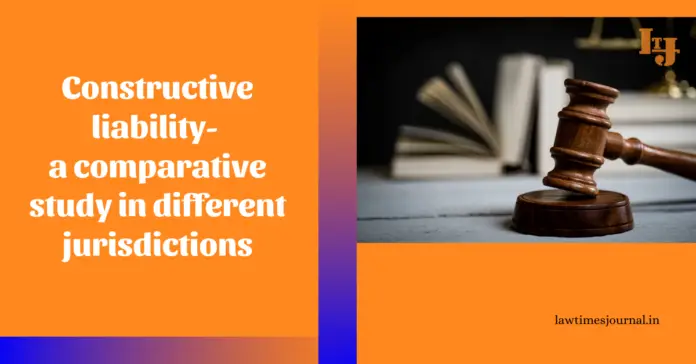
Criminal liability is always established where there exists the guilty mind and the criminal act in consonance with that guilty mind. This rule of criminal liability is based on the maxim “Actus Non FacitReum Nisi Mens Sit Rea”, which means there can be no criminal act without a guilty mind. Therefore, criminal liability arises where there exists both mens rea and actus reus and hence in all cases, the person who has committed the crime will be punished. Constructive liability is an exception to this general rule of criminal liability.
Constructive liability is the one where the liability is not determined by the existence of the fundamental elements of crime. The liability is based on a Latin maxim “versari in re illicita” which means a person may also be criminally held liable for any consequences resulting from his unlawful conduct. Therefore, the person may not be having any knowledge of such consequences but he will be held criminally liable for all such consequences if they are resulting from the conduct of the same person. This concept of constructive liability can be traced from various jurisdictions of criminal law including the Indian criminal justice system.
Constructive liability under Indian Criminal Law
The Indian Penal Code recognizes the concept of constructive liability under Sections 34, 120A and 149. All these provisions establish joint liability of the persons who may not be directly involved in the commission of the offence, but will be sharing common intention or common object with the persons who have committed the offence.
Under Section 34 of IPC, it is very clear that the criminal liability of a person depends on his involvement in the common intention and not on the overt act committed in consonance with that common intention. In the case of Ram Bilas Singh v. State of Bihar[i], the Supreme Court held that the person to be convicted under section 34 need not have indulged in the overt acts, but his presence in the prior planning for commission of such acts in furtherance with a common intention is sufficient to make the person liable.
Therefore, the concept of constructive liability is clearly established under Section 34 and the same concept is adopted under the provisions of criminal conspiracy, where the parties to the agreement to do an illegal act are held criminally liable though there are no instances of any illegal acts committed.
Further, under Section 149 of IPC, every member of the unlawful assembly is held liable for the acts of the unlawful assembly. Mere membership of unlawful assembly is sufficient to prove the liability and the prosecution need not prove that the accused has committed the specific act in furtherance of the common object[ii]. The Courts have also recognised that the presence of an active mind to achieve the common object is sufficient in holding the person constructively liable for the offence under Section 149 of IPC[iii].
Constructive liability under English Criminal Law-
The English Common Law requires the proof of mens rea in all cases of establishing criminal liability. But in exceptional cases of public nuisance, criminal libel, outraging public decency, blasphemous libel and criminal contempt of court, the proof of mens rea need not be provided by the prosecution to establish criminal liability of the accused.
If the consequences of the act of accused are causing injury to another, the criminal liability is constructively considered. The most vigorous application of constructive liability under the English law can be traced from the offence of manslaughter. If a person’s acts are such that a reasonable man can assess the consequence of the acts will be causing the death of a man. Then, the person responsible for such acts is held liable for the offence of manslaughter.
Constructive Liability under the US Criminal Law-
In the United States, constructive liability is recognized only in cases involving minor offences such as parking violations, drink driving, etc., where mens rea need not be proved. The US Supreme Court has quashed the order for deportation where the conviction was one of strict liability and the offence did not involve a crime of violence[iv]. Therefore, under US criminal law for all the major offences the proof of mens rea is essential.
Constructive Liability under Canadian Criminal Law-
Canadian criminal law has recognized the concept of constructive liability as strict and absolute liability. The Crown would be relieved from establishing mens rea in the cases which involve the offences of strict and absolute liability. This rule was established by the Supreme Court of Canada in the case of R. v. City of Sault Ste-Marie[v].
Constructive Liability under Australian Criminal Law-
The Australian Criminal Law creates constructive liability under specific circumstances which involve the industrial offences such as pollution in terms of strict liability. Therefore, the concept of constructive liability is followed as strict and absolute liabilities under the Australian criminal law.
Therefore, the concept of constructive liability is usually observed in all the jurisdictions in cases involving a higher degree of damage caused to the public. The concept of constructive liability is recognized in different forms such as strict liability, absolute liability and vicarious liability. Under criminal law, strict and absolute liabilities are recognized by extending the culpability to the consequences of the unlawful conduct. But vicarious liability is popularly followed under civil law.
“The views of the authors are personal“
Frequently Asked Questions-
Is constructive liability observed under the criminal law jurisprudence of Germany?
The criminal law of Germany is based on the concept that “nullapoena sine culpa” which means that there can be no punishment without guilt. Therefore, constructively extending liability without proof of guilt is not accepted under the criminal law of Germany.
Reference
[i] AIR 1989 SC 1593
[ii] State of Maharashtra v. Joseph MingelKoli, (1997) 2 Crimes 228 (Bom)
[iii] Amerika Rai v. State of Bihar, AIR 2011 SC 1379.
[iv]Leocal v. Ashcroft, 543 U.S. 1 (2004)
[v][1978] 2 SCR 1299.





